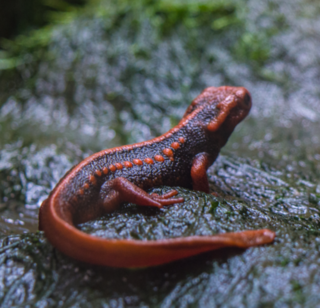
Loei, is one of the more sparsely populated provinces (changwat) of Thailand. It lies in the Isan region of upper northeastern Thailand. Neighboring provinces are Nong Khai, Udon Thani, Nong Bua Lamphu, Khon Kaen, Phetchabun, and Phitsanulok. In the north it borders Xaignabouli and Vientiane province of Laos.

Salamandridae is a family of salamanders consisting of true salamanders and newts. Salamandrids are distinguished from other salamanders by the lack of rib or costal grooves along the sides of their bodies and by their rough skin. Their skin is very granular because of the number of poison glands. They also lack nasolabial grooves. Most species of Salamandridae have moveable eyelids but lack lacrimal glands.
Phu Thai is a Southwestern Tai language spoken in Laos and Thailand. Although it appears different from the Isan and the Lao languages, it is spoken in areas where these languages are predominant and has been influenced by them. Comparisons of Phu Thai with other Tai languages such as Tay Khang have not yet been done systematically enough to yield convincing results.
Another aspect of Phu Thai is its contact with the Katuic languages, a branch of the Austroasiatic languages. Whether in the Phu Thai areas of Central Laos or in more recent locations of Northeastern Thailand, one can find, along with Phu Thai, a few Katuic dialects known locally as Bru, So or Katang. James R. Chamberlain (2012) focusing on anthropological issues describes “the Phou Thay – Brou relationship” as a “symbiosis” and states that “the Phou Thay – Brou relationship has never evolved into a feudal system”.

Tylototriton shanjing, the emperor newt, Mandarin newt or Mandarin salamander, is a highly toxic newt native to China.

Tylototriton verrucosus is a species of newt found in the Indian subcontinent and Southeast Asia. Common names include: Himalayan newt, crocodile newt, crocodile salamander, Himalayan salamander, red knobby newt.

Tylototriton is a genus of newts known as crocodile newts or knobby newts. About 36 known species are in this genus. Many species have been described just recently. They range from northeastern India and Nepal through Burma to northern Thailand, Laos, Vietnam, and southern China.
The red-tailed knobby newt or Kweichow (crocodile) newt is a species of salamander in the family Salamandridae. It is found in western Guizhou and north-eastern Yunnan, China. It is most closely related to emperor newt and Himalayan newt.

Limnonectes gyldenstolpei is a species of frog in the family Dicroglossidae. It is found in northern Thailand, Laos, and southwestern Cambodia.

Phu Hin Rong Kla National Park is a national park located in the Loei and Phitsanulok Provinces of Thailand. The protected area is located in the forested mountains of the Luang Prabang Range close to the border with Laos and is part of the Luang Prabang montane rain forests ecoregion. The park was the base of operations of the long fight of Thai combatant in communist war of Thailand.
Fejervarya triora is a species of frogs belonging to the family Dicroglossidae. Its type locality is in Phu Chong-Na Yoi National Park, Ubon Ratchathani Province in the far east of Thailand. It is also known from Mukdahan National Park in Mukdahan Province, and also Pha Taem National Park, Ubon Ratchathani Province. So far, it is only known from eastern Thailand, although it is not unlikely that it occurs in adjacent Laos too. It has been found in a range of forested habitats.

The Luang Prabang Range, named after Luang Prabang, is a mountain range straddling northwestern Laos and Northern Thailand. Most of the range is located in Sainyabuli Province (Laos), as well as Nan and Uttaradit Provinces (Thailand), with small parts in Phitsanulok and Loei Provinces. Several rivers such as the Nan, Pua and Wa rivers, have their sources in this range. Phu Fa waterfall, the biggest and the tallest waterfall in Nan Province, is also located in these mountains. This range is part of the Luang Prabang montane rain forests ecoregion.

Pha Taem National Park (Thai:อุทยานแห่งชาติผาแต้ม) is a national park on the Mekong River in Ubon Ratchathani Province, northeast Thailand. Phou Xieng Thong National Protected Area in Laos is on the opposite side of the river.
Tylototriton vietnamensis, the Vietnamese crocodile newt or Vietnamese knobby newt, is a species of newt in the family Salamandridae. It is known from four localities in northern Vietnam where it occurs in and near ponds within dense bamboo vegetation. It is quite likely that it also will be found in adjacent areas of China and possibly Laos. It is possible that specimens earlier identified as T. asperrimus are in fact T. vietnamensis. However, based on molecular genetic data, its closest relative is T. hainanensis.
Tylototriton notialis, the Laos knobby newt, is a species of newt in the family Salamandridae. It is only known from its type locality in the Nakai-Nam Theun Biodiversity Conservation Area, Khammouane Province, central Laos. The type locality is an evergreen mixed deciduous–pine forest; the newts were found in and near a small stream. It is likely that Laos knobby newt will also be found in adjacent areas of Vietnam. Based on molecular genetic data, it belongs to the Tylototriton asperrimus group of knobby newts. Laos knobby newt is a small newt, with total length of about 11–14 cm (4.3–5.5 in).

Tylototriton ziegleri, also known as Ziegler's crocodile newt or Ziegler's knobby newt, is a species of newt in the family Salamandridae. It is currently known from Hà Giang and Cao Bằng provinces in northern Vietnam, although its actual range probably wider; there is a photograph to suggest it also occurs in Lào Cai Province in Vietnam, and its range likely extends to Yunnan in southern China. Based on molecular genetic data, Tylototriton ziegleri belongs to the "Tylototriton asperrimus group" of newts. The specific name ziegleri honours Thomas Ziegler, a German herpetologist.

Phu Ruea National Park is a national park in Loei Province, Thailand. The park is centred on Phu Ruea mountain, a popular, scenic peak in the Phetchabun Mountains. The park was established on 26 July 1979.
Phu Pha Thoep National Park, formerly known as Mukdahan National Park, is a national park in Mukdahan Province, Thailand. This park, one of the country's smallest national parks, is home to unusual rock formations and a cave with ancient hand paintings.
Tylototriton uyenoi, the Chiang Mai crocodile newt, is a newt endemic to Chiang Mai Province, Thailand. It was distinguished from Tylototriton shanjing, the emperor newt, in 2013. The species was named in honor of herpetologist Shun-ichi Ueno. T. uyenoi is one of the few salamander species endemic to Thailand.
Tylototriton shanorum is a newt endemic to Shan State, Myanmar, where it was recorded in Taunggyi.

The angular-headed newt, also known as angular-headed crocodile newt, is a species of salamander in the family Salamandridae from Thailand, Laos, and Vietnam. Its unique orange markings help to distinguish it from other species, and also gave it the nickname "Star-Trek newt", as it resembles the ridges on the head of the fictional Klingon species from the television show Star Trek.











